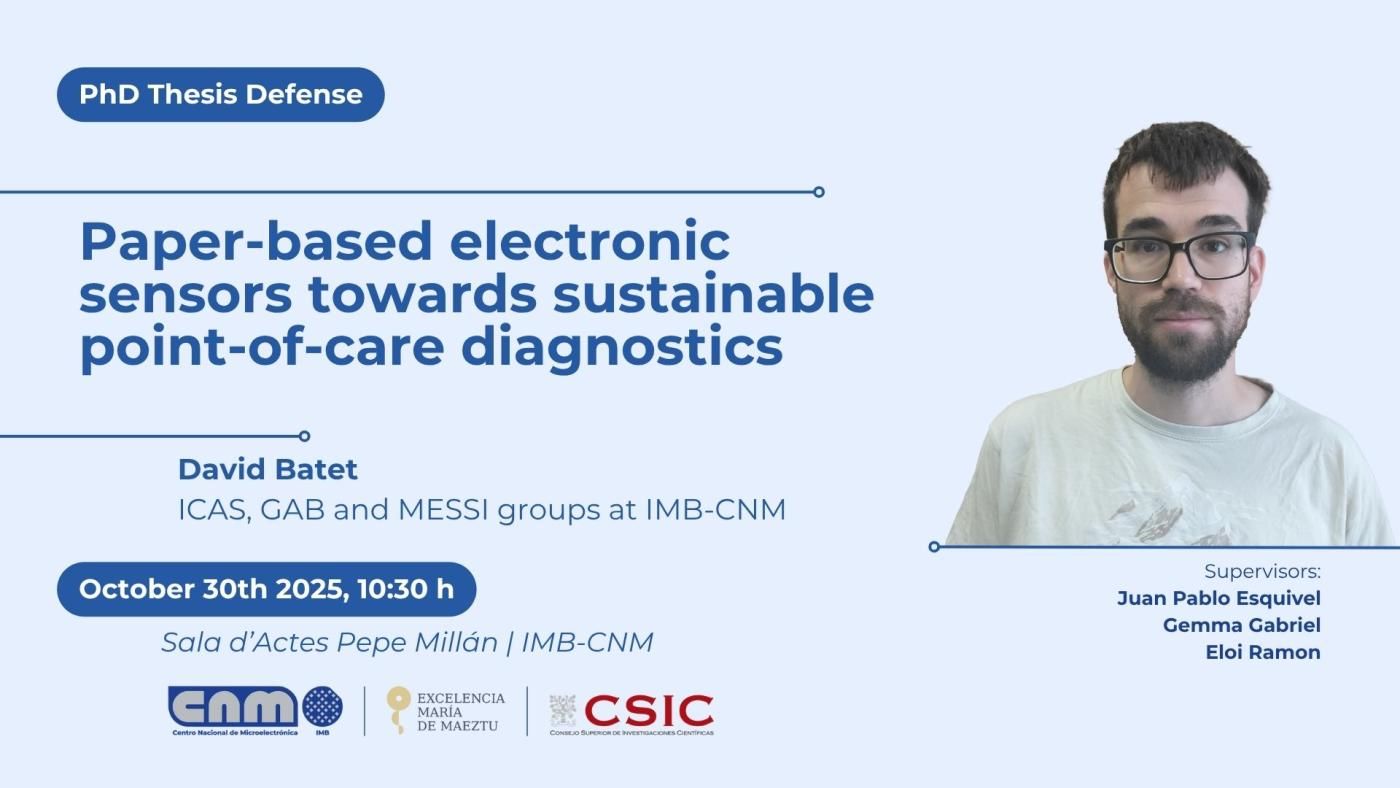PhD Thesis Defense by David Batet, predoctoral researcher at IMB-CNM.
Supervisors:
- Juan Pablo Esquivel (BCMaterials)
- Gemma Gabriel (IMB-CNM)
- Eloi Ramon (IMB-CNM)
PhD Committee:
- César Fernández (IMB-CNM)
- Almudena Rivadeneyra (Universidad de Granada)
- Daniela Correia (Universidade do Minho)
University: Universitat Autònoma de Barcelona
About the thesis
Digitalization, driven by rapid progress in electronic technologies, has profoundly transformed current societies. Nevertheless, it has also derived in a global concern: the annual increase in the amount of waste from electrical and electronic devices (e-waste) generated. Due to the complexity of e-waste, it poses health and environmental risks when improperly managed, apart from leading to the loss of valuable materials. Particularly, in the medical field, electronic point-of-care (PoC) diagnostic tests are discarded every day, contributing to the generation of e-waste. The implementation of circular economy in the design and fabrication of electronic devices would help mitigate this issue. Among the different possible circular end-of-life routes, biodegradation allows organic matter to be converted into simple molecules, which can be converted back into organic molecules through biosynthesis processes. This thesis presents the development of printed disposable self-powered sensors for PoC diagnosis based on biodegradable materials. With a focus on sustainability, printing technologies were selected for device fabrication due to their low energy consumption, waste generation, and cost compared to conventional microfabrication. First, the differences between three printing technologies (inkjet printing, screen printing, and direct ink writing (DIW)) were evaluated utilizing commercial conductive inks. The influence of different paper substrates on the properties of printed films was also studied. Owing to their biodegradability, paper substrates were chosen as materials for the development of sensing devices, so it was relevant to understand how they may affect printed patterns. Secondly, aqueous binary and ternary inks for DIW were formulated combining different conductive fillers and cellulose nanofibers (CNF) for their utilization as a working electrode of an amperometric sensor. Electrical and electrochemical characterization was performed with the developed composites and the ones offering the best balance between performance and biodegradability potential were selected. Amperometric detection of glucose was demonstrated utilizing the selected composite printed on paper substrates. Parallelly, several sustainable electrochemical energy storage devices (EESDs) based on the biopolymer ι-carrageenan were developed. This biopolymer was utilized in the fabrication of solid electrolyte membranes, containing a bio-based deep eutectic solvent as ionic conductor, for EESDs and in the formulation of aqueous electrically conductive inks. The list of EESDs fabricated include sustainable supercapacitors, batteries screen-printed on paper substrates, and self-standing casted batteries. Finally, the materials utilized in the development of EESDs and amperometric sensors were combined for the development of self-powered glucose sensors. These sensors were based on biofuel cells that utilized the oxidation of glucose to generate power, so the performance of fuel cells was dependent on glucose concentration. The developed fuel cells, screen-printed on paper substrates, were fabricated avoiding the use of metallic conductive elements and non-biodegradable polymers. The response of the fuel cells when connected to a resistor was studied and the results were used to demonstrate their compatibility with a minimalistic electronic circuit for signal transduction. All in all, this thesis demonstrates that alternative electronic PoC devices and EESDs with a low environmental impact and a transient end-of-life are possible.





